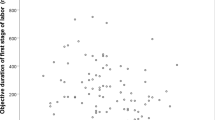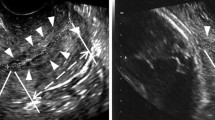Abstract
Purpose
Cervical length during the first trimester of pregnancy has not been completely investigated yet. The objective of our study is to compare cervical size in the first ten gestational weeks with that of non-pregnant women, and to determine its correlation with maternal factors, including age, anthropometric features, and reproductive history.
Methods
We collected retrospective data about women who applied to the Obstetrics and Gynecology Outpatients Facility of Udine between February and June 2009, selecting both pregnant and non-pregnant women possessing a transvaginal ultrasonographic measurement of their cervix, and focusing on their age, parity, BMI, cervical, and uterine size. Data were analyzed by R (version.2.8.0), considering significant P < 0.05.
Results
135 women were recruited. By multivariate linear regression, both cervical length and width result independently influenced by pregnancy status, and among non-pregnant nullipara, cervical length results to be significantly lower in women younger than 20 (P < 0.05).
Conclusions
During the first ten gestational weeks, cervix results to be longer and wider than in non-pregnant women, suggesting the possible existence of early gestational, morphological, uterine, and cervical modifications. Women under the age of 20 have a significantly shorter cervix, suggesting an incomplete cervix maturity in this group of women, which may justify the higher prevalence of pre-term births in teenage pregnancies.



Similar content being viewed by others
References
Iams JD, Goldenberg RL, Meis PJ, Mercer BM, Moawad A, Das A et al (1996) The length of the cervix and the risk of spontaneous premature delivery National Institute of Child Health and Human Development Maternal Fetal Medicine Unit Network. N Engl J Med 334(9):567–572
Sunagawa S, Takagi K, Ono K, Miyachi K, Kikuchi A (2008) Comparison of biochemical markers and cervical length for predicting preterm delivery. J Obstet Gynaecol Res 34(5):812–819. doi:10.1111/j.1447-0756.2008.00844.x
Adhikari K, Bagga R, Suri V, Arora S, Masih S (2009) Cervicovaginal HCG and cervical length for prediction of preterm delivery in asymptomatic women at high risk for preterm delivery. Arch Gynecol Obstet. doi:10.1007/s00404-009-0957-8
Urbaniak T, Tomaszewska K, Klejewski A (2005) Transvaginal ultrasonography of the cervix length and the prediction of preterm delivery. Ginekol Pol 76(7):543–547
yan Shi C, yan Zhang Y, zhi Jin Y, Dong Y (2003) Study of the cervix of normal pregnancy and threatened preterm delivery using transvaginal sonography. Zhonghua Fu Chan Ke Za Zhi 38(5):264–266
Theron G, Schabort C, Norman K, Thompson M, Geerts L (2008) Centile charts of cervical length between 18 and 32 weeks of gestation. Int J Gynaecol Obstet. 103:144–148
Holcomb WL, Smeltzer JS (1991) Cervical effacement: variation in belief among clinicians. Obstet Gynecol 78(1):43–45
Yost NP, Bloom SL, Twickler DM, Leveno KJ (1999) Pitfalls in ultrasonic cervical length measurement for predicting preterm birth. Obstet Gynecol 93(4):510–516
Sonek JD, Iams JD, Blumenfeld M, Johnson F, Landon M, Gabbe S (1990) Measurement of cervical length in pregnancy: comparison between vaginal ultrasonography and digital examination. Obstet Gynecol 76(2):172–175
Andersen HF (1991) Transvaginal and transabdominal ultrasonography of the uterine cervix during pregnancy. J Clin Ultrasound 19(2):77–83
Berghella V, Tolosa JE, Kuhlman K, Weiner S, Bolognese RJ, Wapner RJ (1997) Cervical ultrasonography compared with manual examination as a predictor of preterm delivery. Am J Obstet Gynecol 177(4):723–730
Guzman ER, Mellon C, Vintzileos AM, Ananth CV, Walters C, Gipson K (1998) Longitudinal assessment of endocervical canal length between 15 and 24 weeks’ gestation in women at risk for pregnancy loss or preterm birth. Obstet Gynecol 92(1):31–37
Rozenberg P, Gillet A, Ville Y (2002) Transvaginal sonographic examination of the cervix in asymptomatic pregnant women: review of the literature. Ultrasound Obstet Gynecol 19(3):302–311. doi:10.1046/j.1469-0705.2002.00645.x
Grimes-Dennis J, Berghella V (2007) Cervical length and prediction of preterm delivery. Curr Opin Obstet Gynecol 19(2):191–195. doi:10.1097/GCO.0b013e3280895dd3
Saul LL, Kurtzman JT, Hagemann C, Ghamsary M, Wing DA (2008) Is transabdominal sonography of the cervix after voiding a reliable method of cervical length assessment? J Ultrasound Med 27(9):1305–1311
Berghella V (2009) Novel developments on cervical length screening and progesterone for preventing preterm birth. BJOG. 116(2):182–187. doi:10.1111/j.1471-0528.2008.02008.x
Davies G, Ottenhof C, Woodman M, Farley A, Julien N, Vugt DV et al (2008) Cervix length and relaxin as predictors of preterm birth. J Obstet Gynaecol Can 30(12):1124–1131
Meijer-Hoogeveen M, Holsbeke CV, Tweel IVD, Stoutenbeek P, Visser GHA (2008) Sonographic longitudinal cervical length measurements in nulliparous women at term: prediction of spontaneous onset of labor. Ultrasound Obstet Gynecol 32(5):652–656. doi:10.1002/uog.5291
Erasmus I, Nicolaou E, van Gelderen CJ, Nicolaides KH (2005) Cervical length at 23 weeks’ gestation—relation to demographic characteristics and previous obstetric history in South African women. S Afr Med J 95(9):691–695
Meijer-Hoogeveen M, Roos C, Arabin B, Stoutenbeek P, Visser GHA (2009) Transvaginal ultrasound measurement of cervical length in the supine and upright positions versus Bishop score in predicting successful induction of labor at term. Ultrasound Obstet Gynecol 33(2):213–220. doi:10.1002/uog.6219
Smith GCS, Celik E, To M, Khouri O, Nicolaides KH, Group FMFSTS (2008) Cervical length at mid-pregnancy and the risk of primary cesarean delivery. N Engl J Med 358(13):1346–1353
Rao A, Celik E, Poggi S, Poon L, Nicolaides KH, Group FMFPP (2008) Cervical length and maternal factors in expectantly managed prolonged pregnancy: prediction of onset of labor and mode of delivery. Ultrasound Obstet Gynecol 32(5):646–651. doi:10.1002/uog.6211
Chao AS, Chao A, Hsieh PCC (2008) Ultrasound assessment of cervical length in pregnancy. Taiwan J Obstet Gynecol 47(3):291–295
Uyar Y, Erbay G, Demir B, Baytur Y (2009) Comparison of the Bishop score, body mass index and transvaginal cervical length in predicting the success of labor induction. Arch Gynecol Obstet. doi:10.1007/s00404-008-0915-x
Ennen CS, Bofill JA, Magann EF, Bass JD, Chauhan SP, Morrison JC (2009) Risk factors for cesarean delivery in preterm, term and post-term patients undergoing induction of labor with an unfavorable cervix. Gynecol Obstet Invest 67(2):113–117. doi:10.1159/000166307
Eggebø TM, Økland I, Heien C, Gjessing LK, Romundstad P, Salvesen KA (2009) Can ultrasound measurements replace digitally assessed elements of the Bishop score? Acta Obstet Gynecol Scand 88(3):325–331. doi:10.1080/00016340902730417
Petrovic D, Novakov-Miki A, Mandi V (2008) Socio-demographic factors and cervical length in pregnancy. Med Pregl 61(9–10):443–451
Stevens-Simon C, Barrett J, McGregor JA, French J, Persutte W (2000) Short cervix: a cause of preterm delivery in young adolescents? J Matern Fetal Med 9(6):342–347
Badouraki M, Christoforidis A, Economou I, Dimitriadis AS, Katzos G (2008) Sonographic assessment of uterine and ovarian development in normal girls aged 1–12 years. J Clin Ultrasound 36(9):539–544. doi:10.1002/jcu.20522
Lao TT, Ho LF (1997) The obstetric implications of teenage pregnancy. Hum Reprod 12(10):2303–2305
Lao TT, Ho LF (1998) Obstetric outcome of teenage pregnancies. Hum Reprod 13(11):3228–3232
Usta IM, Zoorob D, Abu-Musa A, Naassan G, Nassar AH (2008) Obstetric outcome of teenage pregnancies compared with adult pregnancies. Acta Obstet Gynecol Scand 87(2):178–183
Guzman E, Mellon C, Vintzileos A, Ananth C, Walters C, Gibson A (1998) Longitudinal assessment of endocervical canal length between 15 and 24 weeks’ in women at risk for pregnancy loss or preterm birth. Obstet Gynecol 92:31–37
Ozdemir I, Demirci F, Yucel O, Erkorkmaz U (2007) Ultrasonographic cervical length measurement at 10–14 and 20–24 weeks gestation and the risk of preterm delivery. Eur J Obstet Gynecol Reprod Biol 130:176–179
Conflict of interest statement
None.
Author information
Authors and Affiliations
Corresponding author
Rights and permissions
About this article
Cite this article
Londero, A.P., Bertozzi, S., Fruscalzo, A. et al. Ultrasonographic assessment of cervix size and its correlation with female characteristics, pregnancy, BMI, and other anthropometric features. Arch Gynecol Obstet 283, 545–550 (2011). https://doi.org/10.1007/s00404-010-1377-5
Received:
Accepted:
Published:
Issue Date:
DOI: https://doi.org/10.1007/s00404-010-1377-5




